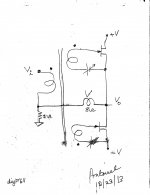One question which I haven't bumped into here is the actual importance of matching components.
There seems to be very much emphasis on good matching, but has anyone actually compared how important that is? How much does it affect the actual sound if not pursued? Is it the purity of the music that suffers, soundstage, depth..? Would non-matching affect maybe the last 10% of sound quality?
Trying to learn here... And since I'm the only crazy audiophile DIY enthusiastic I know around here, there's no one to ask... I go to the local store and ask if they'd have some "better parts" for this or that and they give me that eye looking under their eye brows saying he's nuts - and of course they are right. 😀
There seems to be very much emphasis on good matching, but has anyone actually compared how important that is? How much does it affect the actual sound if not pursued? Is it the purity of the music that suffers, soundstage, depth..? Would non-matching affect maybe the last 10% of sound quality?
Trying to learn here... And since I'm the only crazy audiophile DIY enthusiastic I know around here, there's no one to ask... I go to the local store and ask if they'd have some "better parts" for this or that and they give me that eye looking under their eye brows saying he's nuts - and of course they are right. 😀
well - thread is having just 5543 posts , of which few are yours , so you don't need to read them 
pretty much all you need and can imagine to know is already covered ......... few times
in fact , I could answer to you directly , but no way Jose , when asking too much

pretty much all you need and can imagine to know is already covered ......... few times
in fact , I could answer to you directly , but no way Jose , when asking too much

Last edited:
OK, ok - now I understand. I though you were refuring to some separate thread. And the posting part matchies also with the number of threads of course.
Well, I have reached to about thread 200.... I'll keep going.
Thanks!
Well, I have reached to about thread 200.... I'll keep going.
Thanks!
Wow! I remember the first 100+ posts..., The schemo on the first page was hosed-up and nobody listened or saw it for 2-3-400 posts???
😀
😀
Lol. 🙂
Vince - mock up the dimensions in cardboard and see if you have room. It's a really nice chassis, but huge.
Vince - mock up the dimensions in cardboard and see if you have room. It's a really nice chassis, but huge.
With 5U you can bias it up to 1.8A - 2A. 4U will be good up to 1.2A. The problem with amps with two outputs is that heat transfer from a single fet to a sink will most likely to be a bottleneck.
Both transformers work fine in the other side so the problem has to be on the mother board
I have re soldered the tm connections but I guess i'll go over them again tonight.
I know it sounds ridiculous, but the only time I have had that trouble was when either a joint was poorly soldered on one of the transformers connections to the board or the transformer winding itself had broken.(This was very recent and was simply the result of multiple soldering and desoldering from boards.) Check the traces and values surrounding the troublesome section. Post pics if you can.
What about the argument regarding using a steel chassis with a high current power amps? Does this combination cause some kind of interference?
Felt bad for not contributing to this great thread in a long while. So I wrote the attached diyF6 schematic which expands the scope of the parent's versatility.
- Variable loop [or Pass] feedback is enabled because the impedance of the loudspeaker varies with frequency.
- Adaptable to F5s
- I concur with buzzforb's general motto; "shape and reshape the sound; DIYer"
Attachments
Great to hear from you. Yes V is the voice coil of the shown loudspeaker. Thank you for your helpful explanation.Antoinel, if V is the voice coil, then your design is a V/I converter.
Best regards.
- Home
- Amplifiers
- Pass Labs
- F6 Amplifier
